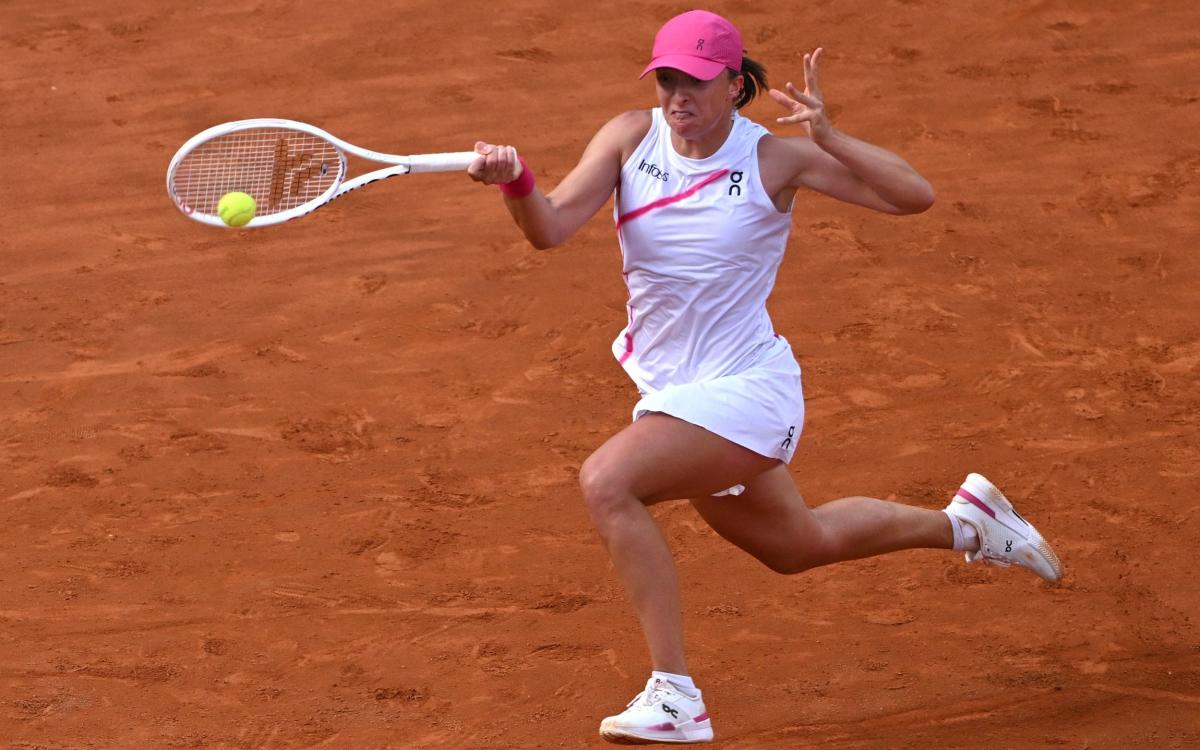On the north side of Roland Garros stands a modernist statue of Rafael Nadal, made of stainless steel. Will there be a matching Iga Swiatek next to it in 10 years?
Just like her idol Nadal, Swiatek is a phenomenon on clay. At just 22 years old, she has already won three French Opens, just one fewer than his tally at the same age.
This week, Swiatek returns to Paris to continue her relentless pursuit of titles. She is riding a 12-match winning streak and has just become the first woman since Serena Williams in 2013 to lift the Madrid and Rome trophies back-to-back.
Her dominance is such that bookmakers are betting on a fourth Coupé Suzanne Lenglen. What makes Swiatek such an irresistible force?
Clay-court specialization
Ever heard of the Magnus effect? This is the quirk of physics that David Beckham used to bend his famous free kicks. Simply put, a spinning ball pivots in the direction it spins.
In professional tennis, the Magnus effect normally causes the groundstroke to sink in flight. The more rotations you perform, the more you neutralize the obstacle of the net. And Swiatek spins the ball like a weather vane in a storm.
With an extreme grip, Swiatek teases the ball with the broad shoulders she inherited from her father, a rower who competed in the Seoul Olympics. The result is rally shots that follow the same dive-bombing and steeply bouncing form as her hero Nadal. And then when she sees an opening, she will hit harder and flatter, sending her missiles flying through the track.
In recent weeks, Swiatek defeated every opponent, including world number 2 Aryna Sabalenka in the finals of both Madrid and Rome.
Also on the wrong side in both events was former US Open finalist Madison Keys, who lost 6-1, 6-3 each time.
“Every ball was basically an inch off the line,” Keys said. “She does a great job of getting the ball early and the ball comes back so quickly that you start to feel rushed.”
Keys also mentioned Swiatek’s sliding motion, which makes her so poised at the end of each shot that it’s almost impossible to wrong-foot her. “She makes you feel like you have to make incredible shots from all over the court. She puts you in a bad position where you start doing things you shouldn’t do.”
On the red stuff, the various elements of Swiatek’s arsenal have made her virtually bulletproof. Just look at her win percentage, which sits at a mighty 88 percent, not far below Nadal’s 91. In both cases, beating these champions on clay at Roland Garros (at least, if they are fully fit) is the biggest challenge. in sports.
Relentless dedication
After Swiatek won Madrid and ticked the last missing clay-court title on her resume, she received an insightful compliment from former world No. 1 Andy Roddick.
“There is a talent in the ability to be and stay disciplined,” Roddick said while recording his entertaining new podcast Served. “That’s her superpower.”
Roddick’s comment reflected the fact that Swiatek is not as spectacular a ball striker as Belarusian Sabalenka. She also doesn’t have a knockout serve like Elena Rybakina, the Kazakh who has a 4-2 lead over Swiatek in their head-to-head matches.
But while Swiatek may be less physically imposing than her Eastern European rivals, she does the invisible things well: footwork, physical fitness, tactical acuity. Almost unique on the WTA Tour, she is a player who never seems to beat herself.
At a time when we have lost so many charismatic champions to boredom and exhaustion (think Ashleigh Barty, Garbine Muguruza and – from time to time – Naomi Osaka), Swiatek’s resilience stands out. She is a high-mileage competitor who is highly motivated: someone who keeps encouraging and pushing herself, even on a cold night in Ostrava.
As Roddick notes, Swiatek’s ability to remain professional every day has elevated her to one of the most elevated companies. She recently surpassed 11,000 points in the rankings – a mark only Serena has previously surpassed – and her lead is such that she is all but guaranteed to overtake both Justine Henin and Barty on the list of longest-serving world No. 1s this season.
The names before those two? Only six, all true legends. Steffi Graf, Serena Williams, Chris Evert, Martina Navratilova, Martina Hingis and Monica Seles.
An inquiring mind
If Swiatek has not yet achieved the same public status as all those legendary predecessors, it is partly a function of her nationality. Poland is neither a juicy commercial market nor a country with a famous tennis heritage.
But there is another possible explanation, and it lies in her introverted personality. During events, Swiatek avoids social obligations and prefers to read a good book – usually a classic from a simpler time. Gone With The Wind, Murder On The Orient Express and The Count of Monte Cristo have all been on her bedside table.
She is neither a natural orator nor a self-publicist. When she is led to the microphone at the end of the match, her voice often shakes. And yet Swiatek has strong opinions and is willing to stand up for what she believes. She is more likely than her peers to call a tournament because of poor organization, or to stand up for the value of the WTA Tour as a whole. “Who’s going to say women’s tennis is boring?” she asked, after her Madrid thriller against Sabalenka.
She is a sharp thinker and her match play shows an instinctive understanding of when to push and when to pull back. In a recent interview, her psychologist Daria Abramowicz explained that she modeled this sixth sense after Osaka (the pre-maternity leave version).
Referring to a match in Toronto where an 18-year-old Swiatek lost in two tight sets, Abramowicz said: “Iga felt like Naomi, if she had break points or something, just used her serve and raised her level. And then Iga thought, ‘So that’s it. That’s a top player. That’s the difference between the best and the rest of the field: that they can capture these important moments.’ And that became a goal to implement this approach.”
Another insight from the same interview, as told by reporter Christopher Clarey, revealed that Swiatek has learned to reduce stress through compartmentalization. As Clarey put it: “She and Abramowicz have focused on regulating her breathing and on compartmentalizing life and individual competitions using the metaphor of the drawer: close one and open the next without touching the past to stand still or look ahead.”
Process, process, process. Swiatek is the opposite of mercurial: a woman who likes to find a reliable pattern and repeat it again and again.
A glimmer of light for the field?
After everything we’ve described, Swiatek’s rivals may be wondering if going to Roland Garros is worth it. Isn’t the French Open a done deal?
Perhaps, but Swiatek has also placed expectations on herself with her flawless structure. As she said after winning Rome last Saturday: “Grand slams are different. There are different pressures on and off the field.”
Outside Roland Garros, her big record also shows this. Yes, Swiatek has a US Open title from 2022. But that is the only Grand Slam final she has reached in 15 attempts on hard or grass courts. At Wimbledon, where the ball slides through in a manner that suits flatter ball strikers, she has a modest total of nine wins from thirteen matches.
The lesson? It’s not easy to be the best. “No1 was a very strange place,” wrote John McEnroe in his autobiography Serious. “The top of the mountain, that icy wind blowing around my head.” McEnroe found several ways to cope, including his infamous tantrums, but still spent five years swapping that top spot with Bjorn Borg, Jimmy Connors and Ivan Lendl.
So far, Swiatek’s reign has been more continuous: 105 weeks, interrupted only by one brief cameo from Sabalenka. She may not enjoy the attention her success brings, but she can handle it. Expect her to handle every challenger with the same methodical ruthlessness in the coming weeks. On clay, Swiatek is the champion who never blinks.
Broaden your horizons with award-winning British journalism. Try The Telegraph free for 3 months with unlimited access to our award-winning website, exclusive app, money-saving offers and more.






